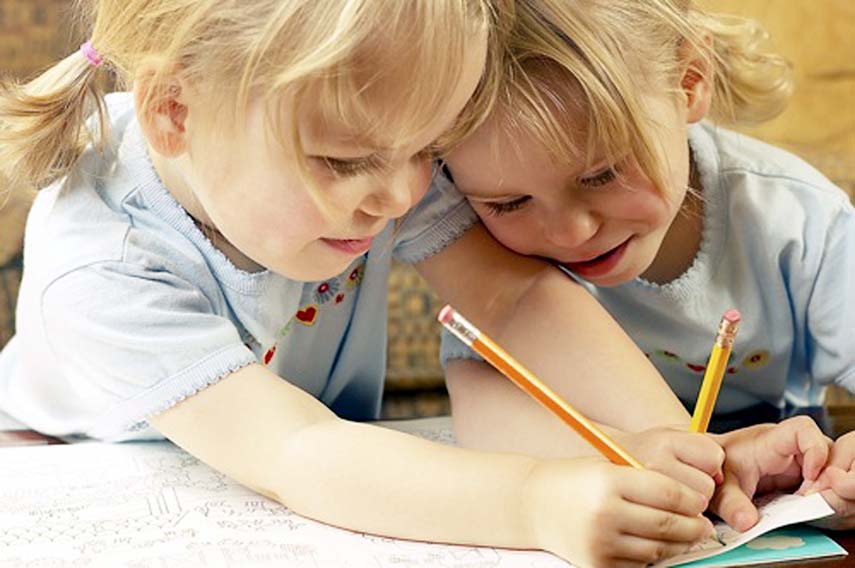
Traci Geiser :
A young child begins her journey of reading and writing as she learns to read and write her first word. For most children, that first word is her name. But just how do preschoolers make the jump to writing their names and the other letters of the alphabet? And is there a right and wrong way to teach your child to write?
“Ideally, the first materials used are not markers and pencils but materials that allow children to strengthen the muscles in their hands needed to properly hold writing implements,” says Mara Guckian, early childhood specialist and managing editor for Teacher Created Resources. “We add a tactile (kinesthetic) component when we practice shaping the letters with different materials. Shaping letters with dough, tracing them on textured paper cutouts, and writing in the sand or salt trays all help children internalize the shape of the letter, while developing their fine motor skills.”
Young children learn best when they are taught using a multisensory approach, involving as many senses as possible. Try a few of these hands-on letter formation and name writing activities for beginning writers and your child will have all the skills she needs as a beginning writer.
Letter Formation
Try a few of these fun activities to help your beginning writer learn the correct strokes when writing the letters of the alphabet:
Air Writing. Have your child write letters in the air first. These large muscle movements will help your child process what she is writing and make it more likely to stick. As she writes the letter, have her say the letter name or the directions for writing the letter. For example, for the letter T, she might say, “Start at the top, go straight down. Pick up your pencil and cross it.”
Foamy Fun. While your child is in the tub, spray a bit of shaving cream on the side of the tub or wall. On a hot day this is also fun to do outside, and your patio table will sparkle when you’re done! Allow your child to practice writing letters, and then erase and try another set. A playful challenge will get your child even more excited to write.
Kitchen Tracing. Pour a small amount of sand or salt in a cake pan or baking dish. Allow your child to practice tracing letters without the pressure of more permanent writing utensils such as markers and crayons. If she makes a mistake, she can simply erase what she wrote and try again.
Paint Practice. For a non-messy alternative to fingerpaint, put a bit of fingerpaint inside a quart or gallon zipper bag. Remove the air, seal the bag and double the seal with some masking or duct tape. Your child can practice tracing letters on the outside of the bag, manipulating the paint with no mess or cleanup!
Learn Your Letters. When she is ready to move to paper, give her large sheets of paper and show her the strokes to make different letters. If you can give the letters human characteristics, it will be even more fun! (For example, a letter E is a straight line with a hat, a belt and a shoe.)
Name Writing
Before your child begins to write her name, she will need some practice identifying the letters in her name. Try a few of these fun name games and your child will master her John Hancock in no time!
If your child is young, she may find it easier to identify and write all uppercase letters first. Later on you can add the traditional written form with the first letter capitalized and the rest lowercase when you teach her to write her name the “kindergarten way.” Uppercase letters are much easier to distinguish and write – for example, B, D, P and Q rather than b, d, p and q. Most young children do not have the fine motor control necessary to form lowercase letters and can become quickly frustrated.
Puzzle Practice. Make a name puzzle by writing your child’s name in large letters on a sheet of paper. Cut the letters apart and have your child reassemble the letters of her name in the correct order. Click here for more info on how to make your own name puzzle.
Sand Writing. Write the letters of your child’s name on a sheet of sandpaper. Allow her to trace the letters with her finger for a tactile name experience!
Trace the Name. When she is ready to begin writing her name, write the letters in large letters on a big sheet of paper. Have your child first trace the letters with her finger several times, then the eraser side of the pencil, and then the pencil. Use a dab of paint on the end of her pointer finger to add a bit of color and even more multisensory practice tracing over the letters.
The exciting journey of reading and writing begins with the alphabet. Give your child a great start to a lifetime of writing by providing hands-on experiences with writing. These playful interactions will go a long way in creating a positive attitude about writing for your child!

